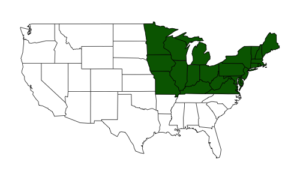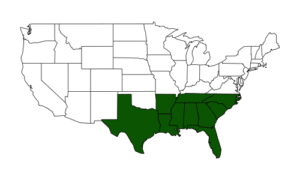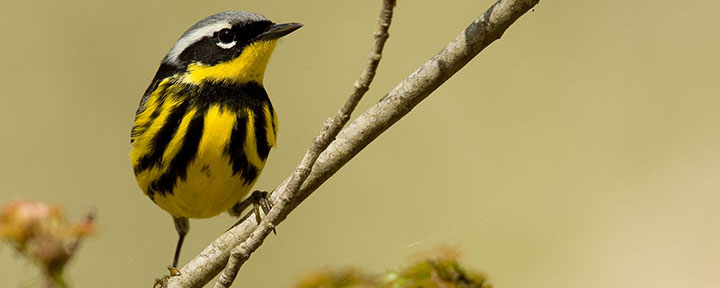Continental Summary
Several widespread pulses of moderate to heavy flights featuring White-rumped Sandpiper, Stilt Sandpiper, Ruddy Turnstone, Common Nighthawk, Eastern Wood-Pewee, Alder Flycatcher, Blackpoll Warbler, and Mourning Warbler punctuated the week across the East, while mid week moderate to locally heavy flights along the eastern Rockies were highlights of the period’s assemblage of Black Tern, Least Flycatcher, Dusky Flycatcher, Plumbeous Vireo, Swainson’s Thrush, MacGillivray’s Warbler, and Blue Grosbeak in the West.
Curious what birds will move next? Check out our forecast.
Need a review of our definitions for regions, species on the move, and migration amounts? Please visit this link.
Quick Links to Regions
Upper Midwest and Northeast |
Gulf Coast and Southeast |
Great Plains |
West |
Upper Midwest and Northeast
Scattered light to moderate flights were the norm for the first half of the period, as more marginal conditions that included unfavorable winds, cooler temperatures and light precipitation moved into the region. By Tuesday and Wednesday many birds stayed on the ground, awaiting the arrival of more favorable conditions arriving from the West. Wednesday night saw these conditions reach the Mississippi, where moderate to heavy flights ensued. The end of the period saw these conditions spread to the Atlantic, with moderate to locally heavy flights from the central Mississippi River valley east through DelMarVa and the New York Metropolitan area.
Top Movers
Increasing
| Species | Increase from Last Week | % of Checklists Reporting |
|---|---|---|
| Eastern Wood-Pewee | 104% | 17.3 |
| Blackpoll Warbler | 90% | 12.8 |
| Magnolia Warbler | 63% | 18.3 |
| American Redstart | 49% | 27.4 |
| Swainson's Thrush | 41% | 13.1 |
| Red-eyed Vireo | 31% | 31.2 |
| Chestnut-sided Warbler | 28% | 18.2 |
| Tennessee Warbler | 28% | 12.2 |
| Ruddy Turnstone | 156% | 1.3 |
| Dunlin | 51% | 4.5 |
| Veery | 25% | 11.7 |
| Common Nighthawk | 77% | 1.9 |
| Indigo Bunting | 15% | 22.7 |
| Cedar Waxwing | 33% | 7.4 |
| Blackburnian Warbler | 25% | 9.7 |
| Semipalmated Sandpiper | 63% | 2.5 |
| Acadian Flycatcher | 30% | 5.2 |
| Common Tern | 48% | 4 |
| Semipalmated Plover | 45% | 3.8 |
| Eastern Kingbird | 16% | 23.4 |
| Scarlet Tanager | 14% | 20 |
| Common Yellowthroat | 11% | 39 |
| Bobolink | 25% | 5.1 |
| Black Tern | 57% | 0.8 |
| Great Crested Flycatcher | 13% | 25.7 |
Decreasing
| Species | Decrease from Last Week | % of Checklists Reporting |
|---|---|---|
| Ruby-crowned Kinglet | -68% | 2.8 |
| White-throated Sparrow | -50% | 11.2 |
| Blue-headed Vireo | -47% | 4 |
| Yellow-rumped Warbler | -33% | 20.2 |
| Hermit Thrush | -39% | 2.8 |
| Purple Finch | -40% | 3.1 |
| Palm Warbler | -32% | 9.4 |
| Pine Siskin | -38% | 3.6 |
| Swamp Sparrow | -24% | 7.5 |
| Rusty Blackbird | -65% | 0.2 |
| Sharp-shinned Hawk | -41% | 1 |
| Eastern Whip-poor-will | -58% | 0.4 |
| Red-breasted Merganser | -43% | 1 |
| Green-winged Teal | -50% | 0.6 |
| Pectoral Sandpiper | -38% | 0.7 |
| Dark-eyed Junco | -40% | 1.2 |
| Wilson's Snipe | -47% | 0.5 |
Gulf Coast and Southeast
This week saw two primary dichotomies dividing the region, one geographic and one temporal. To the west of the Mississippi River, moderate to locally heavy flights were frequency during the period despite several large areas of passing, intense precipitation. To the east, heavier flights occurred, particularly after the passage of a very early tropical disturbance. In general these larger flights occurred earlier in the week, whereas primarily light to moderate flights prevailed later in the period (after the passage of a substantial cold air mass to the north and east).
Top Movers
Increasing
| Species | Increase from Last Week | % of Checklists Reporting |
|---|---|---|
| Yellow-billed Cuckoo | 29% | 12.2 |
| Eastern Wood-Pewee | 20% | 12.8 |
| Alder Flycatcher | 114% | 0.8 |
| Wilson's Warbler | 25% | 3 |
| Yellow-bellied Flycatcher | 58% | 0.7 |
| Chimney Swift | 12% | 26.2 |
| Western Kingbird | 21% | 6.2 |
| Mourning Warbler | 38% | 0.9 |
| Common Nighthawk | 18% | 6.2 |
| Canada Warbler | 19% | 2.4 |
| Acadian Flycatcher | 13% | 6.2 |
| Willow Flycatcher | 18% | 0.9 |
Decreasing
| Species | Decrease from Last Week | % of Checklists Reporting |
|---|---|---|
| Palm Warbler | -96% | 0.1 |
| Cape May Warbler | -85% | 0.4 |
| Yellow-rumped Warbler | -81% | 0.6 |
| Lesser Yellowlegs | -52% | 2 |
| Black-throated Blue Warbler | -49% | 2.7 |
| Blackpoll Warbler | -48% | 3.5 |
| Black-and-white Warbler | -41% | 5.7 |
| Solitary Sandpiper | -46% | 2.3 |
| Savannah Sparrow | -60% | 1 |
| Rose-breasted Grosbeak | -38% | 2.9 |
| Pine Siskin | -51% | 1.4 |
| White-crowned Sparrow | -60% | 0.5 |
| Bobolink | -49% | 1.7 |
| Northern Waterthrush | -45% | 1.8 |
| White-throated Sparrow | -53% | 0.6 |
| Marsh Wren | -77% | 0.2 |
| Greater Yellowlegs | -45% | 1.5 |
| Least Sandpiper | -33% | 4.6 |
| Black-headed Grosbeak | -72% | 0.2 |
| Brown Pelican | -31% | 4.8 |
| Ovenbird | -30% | 4.5 |
| Pectoral Sandpiper | -46% | 0.8 |
| Nashville Warbler | -45% | 1 |
Great Plains
The weekend’s passing disturbance brought scattered moderate to heavy flights before its arrival and migration stoppage in its wake. A cool air mass with unfavorable winds kept birds on the ground for the days to follow, but a change came and quickly by Tuesday night. Warmer air and southerly winds ushered widespread moderate to heavy flights across the region, with some of these flights continuing on sequent nights; however, these subsequent flights did not have the extent nor the intensity of the mid week flight, as another disturbance dropping rain compartmentalized migration to the northern and then southern Plains states on Wednesday and Thursday nights, respectively.
Top Movers
Increasing
| Species | Increase from Last Week | % of Checklists Reporting |
|---|---|---|
| Wilson's Warbler | 123% | 9.8 |
| Eastern Wood-Pewee | 72% | 12.6 |
| Tennessee Warbler | 55% | 19.3 |
| Ovenbird | 112% | 8 |
| White-rumped Sandpiper | 123% | 7.5 |
| Yellow Warbler | 42% | 44.5 |
| Common Nighthawk | 97% | 7.2 |
| Least Flycatcher | 38% | 26.7 |
| Common Yellowthroat | 47% | 18 |
| Northern Waterthrush | 63% | 8.6 |
| Stilt Sandpiper | 87% | 5.9 |
| Bobolink | 73% | 6.3 |
| Black-and-white Warbler | 35% | 14.2 |
| Palm Warbler | 57% | 7.7 |
| Rose-breasted Grosbeak | 26% | 17.4 |
| Pine Siskin | 46% | 8.8 |
| Blue-headed Vireo | 50% | 7.1 |
| Bank Swallow | 59% | 6.9 |
Decreasing
| Species | Decrease from Last Week | % of Checklists Reporting |
|---|---|---|
| Lesser Yellowlegs | -37% | 5.4 |
| Pectoral Sandpiper | -36% | 3 |
| Savannah Sparrow | -31% | 5.5 |
| Baird's Sandpiper | -36% | 3.4 |
| Green-winged Teal | -43% | 2.6 |
| Marbled Godwit | -42% | 1.9 |
| Bufflehead | -55% | 0.9 |
| Northern Shoveler | -16% | 13 |
| American Wigeon | -27% | 4.2 |
| Horned Grebe | -74% | 0.2 |
| American Coot | -17% | 14.2 |
| Ring-necked Duck | -47% | 1.3 |
| American Avocet | -19% | 4.8 |
| Greater Scaup | -79% | 0.1 |
{ PHOTO }
West
A generally quiet weekend for the region, aside from the light to locally moderate flights in California and the Desert Southwest, became more lively during the beginning of the work week. Monday night saw more extensive light to moderate flights across the southern tier of the region, including moderate to locally heavy flights in and to the east of the central and southern Rockies. This area to the east of the Rockies continued to produce on Tuesday and Wednesday nights, although region wide movements were generally less intense through the remainder of the period. Note that eastern Montana ended the week with a moderate to heavy bang.
Top Movers
Increasing
| Species | Increase from Last Week | % of Checklists Reporting |
|---|---|---|
| Swainson's Thrush | 52% | 6.6 |
| Western Wood-Pewee | 42% | 11.6 |
| Yellow Warbler | 27% | 24.4 |
| Cedar Waxwing | 35% | 8.4 |
| Dusky Flycatcher | 43% | 3.9 |
| Western Tanager | 19% | 16.5 |
| Gray Catbird | 146% | 1.2 |
| Chipping Sparrow | 20% | 13.4 |
| Black-headed Grosbeak | 17% | 24.3 |
| Least Flycatcher | 117% | 1.1 |
| Common Grackle | 19% | 7.7 |
| MacGillivray's Warbler | 26% | 4.3 |
| Black Tern | 104% | 1.2 |
| Bullock's Oriole | 14% | 16.1 |
| Broad-tailed Hummingbird | 18% | 7.8 |
| Clay-colored Sparrow | 45% | 1.8 |
| Lazuli Bunting | 16% | 9.7 |
| Warbling Vireo | 14% | 13.2 |
| Olive-sided Flycatcher | 20% | 3.7 |
| House Wren | 10% | 18.4 |
| Plumbeous Vireo | 29% | 3.3 |
| Blue Grosbeak | 22% | 2.7 |
| Barn Swallow | 10% | 26.7 |
Decreasing
| Species | Decrease from Last Week | % of Checklists Reporting |
|---|---|---|
| Least Sandpiper | -59% | 1.1 |
| Semipalmated Plover | -62% | 0.5 |
| Western Sandpiper | -42% | 1.2 |
| Dunlin | -43% | 1 |
| Lesser Yellowlegs | -68% | 0.2 |
| Greater Yellowlegs | -44% | 1.2 |
| Golden-crowned Sparrow | -55% | 0.9 |
| Greater White-fronted Goose | -61% | 0.3 |
| Long-billed Dowitcher | -29% | 2.3 |
| Bufflehead | -33% | 2.5 |
| Marbled Godwit | -26% | 1.3 |
| Varied Thrush | -56% | 0.3 |
| Common Loon | -25% | 1.6 |
| Horned Grebe | -57% | 0.2 |
| Solitary Sandpiper | -53% | 0.2 |
| Brant | -33% | 0.6 |
| Black-throated Gray Warbler | -16% | 4.1 |
| American Pipit | -44% | 0.4 |
–––––––––––––––––––––––––––––––––––
Farnsworth and Van Doren








